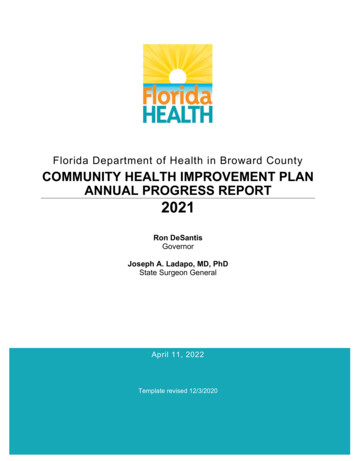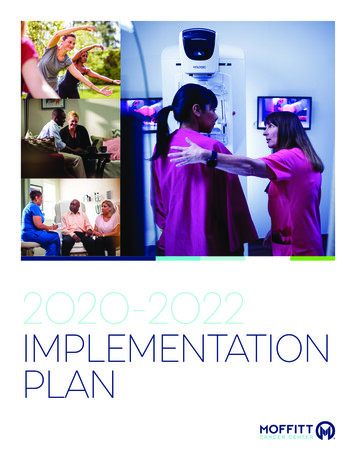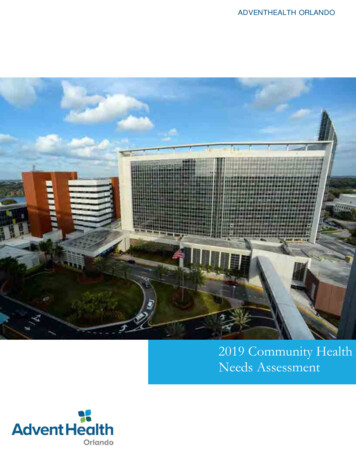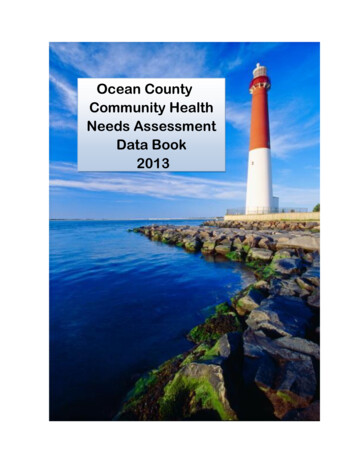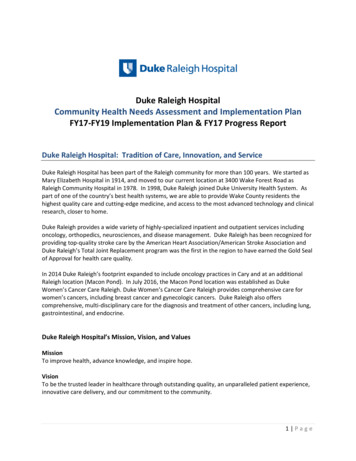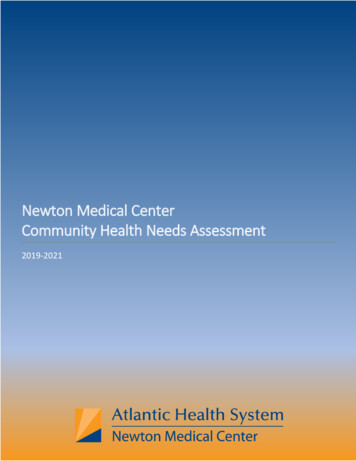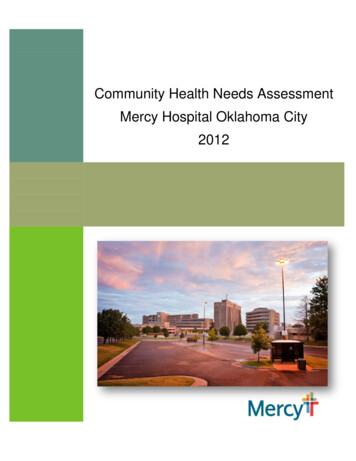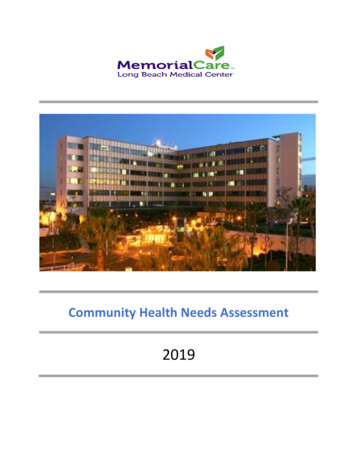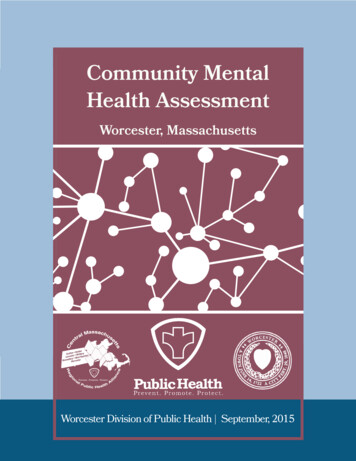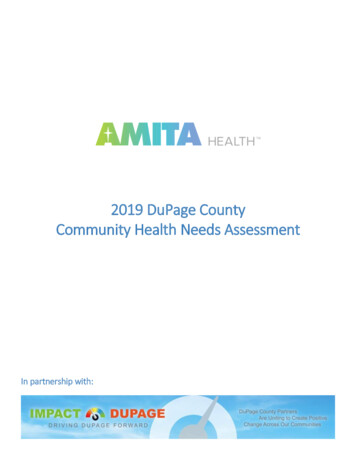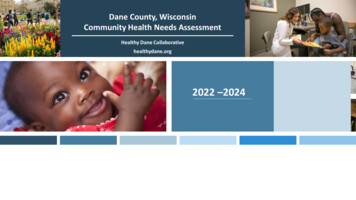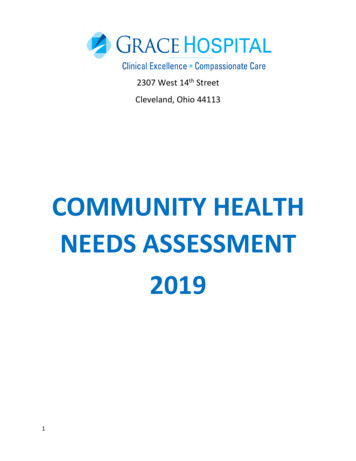
Transcription
2307 West 14th StreetCleveland, Ohio 44113COMMUNITY HEALTHNEEDS ASSESSMENT20191
TABLE OF CONTENTSIntroduction .3Summary of Community Needs Assessment –Cuyahoga County 3About Grace Hospital . 5Community Served by the Hospital & Market Share . .6Priority Health Issues .6Diabetes Related Education .7Ventilator Weaning and Results-------------------------------7Palliative Care and Advance Directive 8LTACH Community Health needs Assessment Action Plan .9Appendix:DRG Analysis .12Grace Hospital Outcomes Analysis . .13Hospital Market Share 14Cuyahoga County Community Needs Assessment .152
INTRODUCTIONThe Patient Protection and Affordable Care Act (ACA), signed into law on March 23, 2010, created newrequirements for not-for-profit hospitals including a requirement for a Community Health NeedsAssessment (CHNA) to be completed every three years. This report was prepared for the Grace Hospitala Long Term Acute Care Hospital (LTACH) located inside South Pointe Hospital in Warrensville Heights,Ohio, Bedford Medical Center in Bedford, Ohio to meet the CHNA requirements for 2019-2020.SUMMARY OF COMMUNITY NEEDS ASSESSMENT (CUYAHOGA COUNTY)Cuyahoga CountyCommunity Health AssessmentExecutive SummaryThe opportunity for all in Cuyahoga County to achieve their full health potential depends upon longterm collaboration among individuals and organizations across sectors. Cuyahoga County is made up of58 separate cities and townships, with Cleveland being the largest. There are two local healthdepartments within the county, the Cleveland Department of Public Health and Cuyahoga County Boardof Health. Multiple hospital systems also have facilities in the county, including Cleveland Clinic,MetroHealth, Southwest General, St.Vincent Charity and University Hospitals, in addition to theCleveland Veterans Affairs Medical Center.The people and the organizations who have come together to gather and analyze the data contained inthe Needs assessment report are committed to utilizing these finding to work together over the longterm in order to achieve equity and a healthier Cuyahoga County.This 2019 collaborative community health assessment will be used to collectively design a communityhealth improvement plan and implementation strategy for the next three years. The five prioritizedareas of collaborative focus for the next three years are, data gathering and analysis, engagement ofcommunity partners through surveys, interviews, community meetings.Five priority areas:-Eliminating structural racismEnhancing trust across sectors, people, communitiesAddressing community conditions, such as reducing poverty and its effectsEnhancing mental health and reducing substance abuseReducing chronic illness and its effectsPrimary Data Collection MethodsDesign3
This community needs assessment report includes both qualitative and quantitative data to provideinsights about the biggest and most pressing health needs effecting people of Cuyahoga County.Qualitative DataKey Stakeholders interviewFocus Group DataQuantitative DataPrimary Data SourceRandom SampleSample SurveySecondary Data SourceHospital DataFuture DataInformation GapsFunding SourceSamplingAdults ages 19 and over living in Cuyahoga County were used as the sampling frame for the adult survey.Since U.S. Census Bureau age categories do not correspond exactly to this age parameters, theinvestigators calculated the population of those 18 years and over living in Cuyahoga County in 2017.There were 987,528 persons ages 18 and over living in Cuyahoga County. The investigators conducted apower analysis to determine what sample size was needed to ensure a 95% confidence level with acorresponding confidence interval of 5% (i.e., we can be 95% sure that the “true” population responsesare within a 5% margin of error of the survey findings.) A sample size of at least 384 responding adultswas needed to ensure this level of confidence. The random sample of mailing addresses of adults fromCuyahoga County was obtained from American Clearinghouse in Louisville, KY.ProcedureData AnalysisIndividual responses were anonymous and confidential. Only group data are available. All data wereanalyzed by health education researchers at the University of Toledo using SPSS 17.0. Crosstabs wereused to calculate descriptive statistics for the data presented in this report. To be representative ofCuyahoga County, the data collected was weighted by age, gender, race, and income using 2010 censusdata. Multiple weightings were created based on this information to account for different types ofanalyses. For more information on how the weightings were created and applied, see Appendix iii.4
LimitationsAs with all county assessments, it is important to consider the findings in light of all possible limitations.First, the Cuyahoga County adult assessment mailings had very high response rates. However, if anyimportant differences existed between the respondents and the non-respondents regarding thequestions asked, this would represent a threat to the external validity of the results (the generalizabilityof the results to the population of Cuyahoga County). In other words, if those who were sent the surveywould have answered the questions significantly differently than those who did respond, the results ofthis assessment would under-represent or over-represent their perceptions and behaviors. If there werelittle to no differences between respondents and non-respondents, then this would not be a limitation.Second, it is important to note that, although several questions were asked using the same wording asthe CDC questionnaires, the adult data collection method differed. CDC adult data were collected usinga set of questions from the total question bank and adults were asked the questions over the telephonerather than as a mail survey.Finally, like all surveys, the self-reported results are subject to lapses in memory and to responding in asocially desirable manner. If these problems occurred it would be a threat to the internal validity of thefindings.Complete report of “CUYAHOGA COUNTY COMMUNITY HEALTH ASSESSMENT2019” is a separate attachment.ABOUT GRACE HOSPITALLTACH – DEFINITION:A Long Term Acute Care Hospital is a specialty hospital that provides acute care services forpatients who are medically complex, critically ill, and require an extended period ofhospitalization.Grace Hospital LTACH resides within South Pointe Hospital in Warrensville Heights, Ohio, BedfordMedical Center in Bedford, Ohio. The LTACH has 50 beds. The facilities are located on the 5thfloor ofSouth Pointe Hospital, the 3rd floor of Bedford Hospital is specifically designed to meet the needs ofpatients requiring extended acute medical care. It provides specialized care for patients who sufferfrom respiratory conditions, cardiac related disorders, trauma, wounds, cancer and other illnessesrequiring acute, long-term care. Specific diagnoses using the LTACH include: 5Respiratory failure requiring ventilator managementCardiopulmonary or cardiovascular diseaseRespiratory disordersPost-surgical complicationsWound careInfectious diseaseNeurological conditionsCongestive heart failureStroke or a cerebral vascular accident
Multi-symptom disordersNutrition therapyThe LTACH also works to provide discharge planning that includes patient and family education for homecare. The LTACH provides case managers and a social worker that work with the patient, the physicianand any family or friend support to prepare the patient for safe discharge to an appropriate setting. AGrace Hospital case manager will conduct and coordinate home health or nursing facilities if the patientrequires placement.COMMUNITY SERVED BY THE GRACE HOSPITALLTACH receives patients from hospitals in the community and 99% of admissions are from hospitals asLTACH serve patient who need long term stay in an acute care setting. Also, 63% of patients come fromCleveland Clinic Health System and 33% from University Health System.Grace Hospital’s community and market is as follows:REFERRALS SOURCES TO GRACE HOSPITALYTD 6/30/2019CCFFAIRVIEWMARYMOUNTHILLCRESTREFERRALS SOURCES TOGRACE HOSPITAL MEDINA00.0%MEDINA00.0%EUCLID72.6%EUCLID41.4%TOTAL 2.0%BEDFORD3011.2%BEDFORD279.5%AHUJA /RICHMOND249.0%AHUJA207.1%TOTAL INTE
PRIORITY HEALTHCARE ISSUESTo prepare this CHNA report data was gathered from multiple sources in an effort to construct a currentand accurate snapshot of the health issues inside the LTACH. Data (See Appendix Table A) was obtainedfrom multiple opinions and were solicited from health experts, community leaders, staff caregivers andpatients within the community served by Grace Hospital LTACH. This information was summarized forfinal consideration by a CHNA team consisting of hospital and system personnel, as well as communitymembers. The community health needs identified were as follows:1. Diabetes Related Education and Support2. Ventilator Weaning and Results3. Palliative Care and Advanced DirectivesAn implementation strategy that will address each of these issues is currently in development. Thestrategy will seek to leverage valuable partnerships that currently exist, identify novel opportunities forsynergy and maximizing programs while deploying specific interventions within the community.Diabetes Related Education and SupportGrace Hospital provides resources thru the Cuyahoga County Community Health Assessment programs.Morning, afternoon and evening classes are offered and facilitated by certified diabetes educations. Thecost of the classes may be covered by Medicare and most insurance companies. H.E.L.P. funds havebeen provided by United Way of Cuyahoga for non-insured participants although funds are limited.Class course content includes: Evaluation of diabetes controlMeal planning – carbohydrate counting, weight management, hyperlipidemiaMedication – oral diabetes medication (pills) – insulinExercise – new and realistic approach to activityStress – physical and emotional stress; sick day managementAn experienced staff of dietitians, and registered nurses help those with diabetes learn to control theirdiabetes by eating healthy, exercising and taking medications the right way.Grace Hospital provides this education for inpatients.To help those with diabetes manage the disease, the Diabetes Partnership of Cleveland (formerly theDiabetes Association of Greater Cleveland) is offering free education classes to help people learn how tomanage theirs or a loved one’s diabetes and to learn healthy food options. Classes are open to thepublic and are taught by an experienced team of diabetes health professionals. Classes are free butregistration is necessary. To register, please call 216-591-0800. For more information please visit ourwebsite at www.diabetespartnership.org.Ventilator Weaning and resultsGrace Hospital admits pulmonary patients directly from acute care hospital Intensive Care Units, but stillrequires ongoing acute medical and nursing care. On average, our patient spends about 25 days in ourinpatient pulmonary program.7
Patients typically have respiratory complications resulting from neurological disorder including musculardystrophy and post-polio syndrome; are currently on a mechanical ventilator and are candidate forventilator weaning; have respiratory complications resulting from spinal cord injury; have difficultymanaging their diagnoses of COPD, emphysema, chronic bronchitis, lung disease and other pulmonaryconditions.Grace Hospital’s Ventilator Weaning Program is designed to help patients who have been dependent ona ventilator, learn how to breathe on their own again. The program uses the latest research andtechnologies, together with multi-disciplinary team approach, to help patients successfully transitionfrom being on a ventilator to breathing independence. Upon arrival to our hospital, the entire care teamsees the patient and develops an individualized plan of care. Grace Hospital’s ventilator weaning rateshave been above 75% for past five years.Some patients – those with spinal cord injuries or neuromuscular disease, for example - may be unableto be weaned from the ventilator. When that is the case, Grace Hospital works with the family todetermine the best course of care after discharge from the hospital. If the patient will be cared for athome, Grace Hospital will train patient and his or her family in “trach” care, suction, home ventilatoroperation and emergency care, also select home health company, check the environment and assist inmaking sure the ventilator is properly placed for patient safety and comfort. Grace Hospital alsocontacts local EMS and utility provider to alert them to the presence of a home ventilator.Palliative Care and Advance E 1.3%HOSPICE51.9%2.8%REHAB51.9%0.7%100.0%100.0%2678
With upon discharge 2% of patients go to Hospice and 6.7% Expiration Rate and also 49.1% of patientsgoing to Skilled Nursing Facility Palliative Care initiative was chosenPalliative Care is medical care and treatment that focuses on preventing and relieving suffering broughton by a chronic condition or disease. The goal is to improve patients’ quality of life and work withfamilies facing issues associated with life-limiting illness. Grace Hospital makes this possible throughearly identification, complete assessment and treatment of pain and attending to any physical,psychological and spiritual needs. Grace Hospital Palliative Care team works closed with the patient’sdoctor to provide coordinated physical, emotional and spiritual care.Grace Hospital’s Palliative Care team provides the following services: Reliving pain and other symptomsIntegrating the psychosocial and spiritual aspects of careUsing the team approach to address the needs of patients and their families, includingbereavement counseling, if neededEnhancing the quality of life and positively influencing the course of illnessPalliative Care is available to anyone who is any stage of a chronic or advances illness such as cancer orother serious condition. This type of care helps patients and their families understand their illness andtreatment options, as well as address financial and community and resource options.An Advanced Directive is an important document to complete and keep on hand. It instructs a patient’sfamily about his or her wishes for end-of-life care, so the family won’t have to make heart-wrenchingdecisions later. This is important because a patient may become physically or mentally unable tocommunicate desires for medical care, if he or she has an accident or become ill. Expressingpreferences in writing helps the family and doctor understand the patient’s wishes.To help people understand more about Advance Directives, Grace Hospital has available severalresources on the Ohio Advance Directive form on the Grace Hospital units.Patients in the inpatient, outpatient and clinic setting are asked if they have an advanced directive, andif they do not, if they would like assistance in filling out one.Anyone interested may also contact the case manager to fill out an Advance Directive and DurablePower of Attorney for health care. The form is notarized onsite and placed in the individual’s medicalrecord and a copy is given to the individual to share with his or her family.Meeting the NeedsHow will the needs identified in this assessment be met? The answer involves a two-step process. Thefirst step is identifying what Grace Hospital is doing currently. The second step is to create an actionplan to address the needs not fulfilled in those current activities. The following provides an overview ofthose current activities.LTACH Community Health needs Assessment Action PlanHEALTH NEEDPalliative Care and AdvancedDirectives9PROPOSED ACTIONS The first action step Physician coming on board A palliative care strategic plan is in development; actionsteps will support the direction of this plan
Diabetes Related Education andSupport Ventilator Weaning and results 10Continue community-based education eventsconcerning advance directivesTransportable Physician Orders for Patient PreferencesInitiate education (MC Strategy)concerning inpatientpalliative careContinue nursing education consortium on end-of-lifecareInitiate end-of-life care education for physiciansCommunity action steps with physicians through:- Quarterly provider meetings- Board of Governors- Need to Know emailsContinue Diabetes management classes through theDiabetes CenterContinue to provide education and self-assessment toolthrough the web siteProvide family with training and ongoing need ofpersons with pulmonary diseaseVentilator education and training for vent dependentpatientsTraining and education for “Trach Care “ and suctioningto care givers and patients- Ventilator support groups led by pulmonologist andclinical psychologyOngoing support and education through BetterBreather Club
TABLE ADRGNo. Cases%4617.2%189Respiratory system diagnosis w ventilator support 96 hoursPulmonary edema & respiratory failure4818.0%871Septicemia or severe sepsis w/o MV 96 hours w MCC155.6%682Renal failure w MCC155.6%19093.4%83.0%166Chronic obstructive pulmonary disease w MCCRespiratory system diagnosis w ventilator support 96hoursOther resp system O.R. procedures w MCC72.6%177Respiratory infections & inflammations w MCC62.2%539Osteomyelitis w MCC62.2%314Other circulatory system diagnoses w MCC51.9%872Septicemia or severe sepsis w/o MV 96 hours w/o MCC31.1%637Diabetes w MCC31.1%862Postoperative & post-traumatic infections w MCC20.7%Other9435.2%267100.0%20720811
Table BOUTCOMESFY2019FY2018HOME4918.4%27.2%ACUTE 2
Table CREFERRALS SOURCES TO GRACE HOSPITALYTD EFERRALS SOURCES TOGRACE HOSPITAL MEDINA00.0%MEDINA00.0%EUCLID72.6%EUCLID41.4%TOTAL 2.0%BEDFORD3011.2%BEDFORD279.5%AHUJA /RICHMOND249.0%AHUJA207.1%TOTAL R114.1%186.4%267100.0%283100.0%13SOUTHPOINTE
CUYAHOGA COUNTY COMMUNITY NEEDSASSESSMENT---201914
Grace Hospital case manager will conduct and coordinate home health or nursing facilities if the patient . Cleveland Clinic Health System and 33% from University Health System. Grace Hospital's . FAIRVIEW 0 0.0% FAIRVIEW 2 0.7% MARYMOUNT 26 9.7% MARYMOUNT 28 9.9% HILLCREST 5 1.9% HILLCREST 6 2.1% SOUTHPOINTE 115 43.1% SOUTHPOINTE 137 48.4 .
